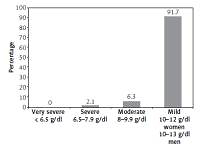Current issue
Archive
Manuscripts accepted
About the Journal
Editorial office
Editorial board
Section Editors
Abstracting and indexing
Subscription
Contact
Ethical standards and procedures
Most read articles
Instructions for authors
Article Processing Charge (APC)
Regulations of paying article processing charge (APC)
GERIATRICS / CLINICAL RESEARCH
Unexplained anemia in the elderly – a real life analysis of 981 patients
1
Department of Pharmacology and Toxicology, Faculty of Medicine and Health Science, University of Zielona Gora, Zielona Gora, Poland
2
Department of Hematology and Bone Marrow Transplantation, Poznan University of Medical Sciences, Poznan, Poland
3
Department of Clinical Transplantology, Medical University of Lublin, Lublin, Poland
Submission date: 2018-12-02
Final revision date: 2018-12-26
Acceptance date: 2019-01-06
Online publication date: 2019-02-05
Publication date: 2020-05-26
Arch Med Sci 2020;16(4):834-841
KEYWORDS
TOPICS
ABSTRACT
Introduction:
We aimed to analyze the prevalence of unexplained anemia (UA) and assess its characteristics, potential causes and impact on survival in an elderly population.
Material and methods:
Medical files of 981 patients aged ≥ 60 years consulted in one primary medical clinic in Poland in 2013–2014 were retrospectively analyzed. Anemia, defined according to WHO criteria, diagnosed during either hospitalization or outpatient treatment, from the age of 60, was included. Unexplained anemia was diagnosed if, based on available clinical data and laboratory tests and other assessments in medical records, none of the well-known types of anemia were identified.
Results:
Of 981 patients with anemia, UA was found in 48 (28.4%) patients (4.9% of those studied) and incidence increased with age (≥ 80 years, 12.3%). In 81.3% no full hematological diagnostics were performed. Patients with UA, as with those with defined anemia, when compared to the group without anemia were older, had more co-morbidities, were more frequently hospitalized, more frequently had dementia syndrome and obtained lower Barthel scores (p < 0.0001). In the groups of patients with UA and defined anemia, there were more deaths than in those without anemia (10% vs. 13% vs. 2%, p < 0.0001) with significant differences in survival rates observed during 3-year follow-up.
Conclusions:
The increasing incidence with age of UA in the elderly population, insufficient diagnosis and the higher mortality of patients with UA in comparison to the group without anemia indicate the need to develop recommendations for its management by primary care physicians.
We aimed to analyze the prevalence of unexplained anemia (UA) and assess its characteristics, potential causes and impact on survival in an elderly population.
Material and methods:
Medical files of 981 patients aged ≥ 60 years consulted in one primary medical clinic in Poland in 2013–2014 were retrospectively analyzed. Anemia, defined according to WHO criteria, diagnosed during either hospitalization or outpatient treatment, from the age of 60, was included. Unexplained anemia was diagnosed if, based on available clinical data and laboratory tests and other assessments in medical records, none of the well-known types of anemia were identified.
Results:
Of 981 patients with anemia, UA was found in 48 (28.4%) patients (4.9% of those studied) and incidence increased with age (≥ 80 years, 12.3%). In 81.3% no full hematological diagnostics were performed. Patients with UA, as with those with defined anemia, when compared to the group without anemia were older, had more co-morbidities, were more frequently hospitalized, more frequently had dementia syndrome and obtained lower Barthel scores (p < 0.0001). In the groups of patients with UA and defined anemia, there were more deaths than in those without anemia (10% vs. 13% vs. 2%, p < 0.0001) with significant differences in survival rates observed during 3-year follow-up.
Conclusions:
The increasing incidence with age of UA in the elderly population, insufficient diagnosis and the higher mortality of patients with UA in comparison to the group without anemia indicate the need to develop recommendations for its management by primary care physicians.
Share
RELATED ARTICLE
We process personal data collected when visiting the website. The function of obtaining information about users and their behavior is carried out by voluntarily entered information in forms and saving cookies in end devices. Data, including cookies, are used to provide services, improve the user experience and to analyze the traffic in accordance with the Privacy policy. Data are also collected and processed by Google Analytics tool (more).
You can change cookies settings in your browser. Restricted use of cookies in the browser configuration may affect some functionalities of the website.
You can change cookies settings in your browser. Restricted use of cookies in the browser configuration may affect some functionalities of the website.



